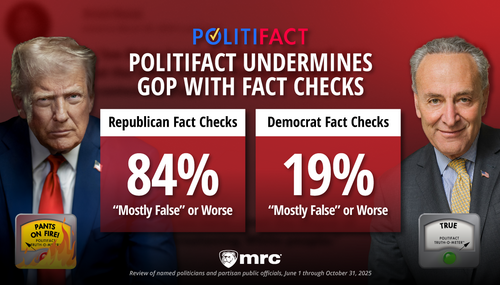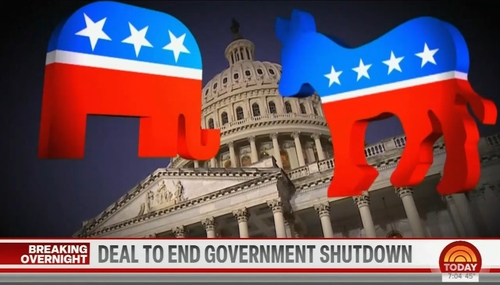
“Obama's tax cuts only go to people who work, so by definition, it's not welfare. Some working people eligible for Obama's tax cut make so little, they do not pay income taxes. But they do pay payroll taxes and other taxes,” Tapper summarized.
In other words, McCain would have been accurate if he’d said “gives an income tax cut to those who don’t pay income taxes — and pays for it by raising income taxes on those who are already shouldering more than half of the nation’s income tax burden.”
But Monday’s piece illustrated the liberal media’s penchant for analyzing tax proposals according to a liberal yardstick — who gets how big a check from the government — rather than by analyzing how the rival tax policies will contribute to greater prosperity (by helping or hurting economic growth, rewarding or punishing job creation, etc.).
In other words, while the media are always checking to see how the candidates “spread the wealth,” they seem not to care if a candidate will help expand the economic pie and make us all wealthier in the long run.
It also marked the fifth time in five months that Good Morning America has cited the liberal Tax Policy Center (an offshoot of two liberal think tanks, the Brookings Institution and the Urban Institute), while conservative tax experts at the Heritage Foundation have never been cited.
Yet last Wednesday, October 15, the Heritage Foundation released a detailed comparison of the Obama and McCain tax plans, and concluded McCain’s proposal does a better job of enhancing prosperity:
Senator McCain’s plan is substantially better at spurring economic growth than Senator Obama’s. This is not surprising, since Senator McCain focuses on economic growth and job creation, while Senator Obama focuses on redistribution of income....Each presidential candidate achieves his stated goal, with Senator McCain generating the most new jobs, growth, and additional income for individuals. Senator Obama’s plan drives up the tax rate for individuals with annual incomes above $250,000 and redistributes money to workers with lower incomes.
Wouldn’t it be fair to have the conservative analysis appear at least once alongside the liberal analysis of who gets what?
Here’s more from Jake Tapper’s “Fact Check” from the October 20 Good Morning America:
JAKE TAPPER: How about this charge from McCain?
SENATOR JOHN MCCAIN: His plan gives away your tax dollars to those who don't pay taxes. That's not a tax cut. That's welfare.
TAPPER [Big red “FALSE” stamp appears onscreen]: That's false. Obama's tax cuts only go to people who work, so by definition, it's not welfare. Some working people eligible for Obama's tax cut make so little, they do not pay income taxes. But they do pay payroll taxes and other taxes.
Here are some tax facts. [Onscreen graphic for source: Tax Policy Center analysis of candidates' plans based on public statements.] If you make up to $18,725, McCain will give you a tax cut of $65, while Obama will give you $567. If you make between $37,000 and $66,000, McCain would give you half of what Obama would. $66,000 to about $110,000 a year, McCain gives you a $1,487 tax cut. Obama will give $1,264.
But here's where the starkest differences come in. If you're in the top one percent, making between $602,000, to $2.8 million, McCain gives you a $109,214 tax cut on average. Obama would raise your taxes on average by $121,689. Those figures are for 2009 and, of course, they're just generalities. We have more detailed information at ABCNews.com.
As he promised viewers, Tapper offered a bit of further explanation at his ABC News blog, “Political Punch.”
Now, some of the key findings of the Heritage Foundation analysis of the two tax plans, authored by William Beach, Karen Campbell, Rea S. Hederman, Jr., and Guinivere Nell and released Wednesday. The quotes are all directly from the report, but I’ve re-arranged the paragraphs and added headings so that the McCain and Obama proposals can be more easily compared.
My summary of their findings: Compared to Obama, McCain's plan adds an extra $100 billion to GDP over the next ten years, more than one million additional jobs, much higher disposable income for a family of four, and a far greater personal savings rate.
GDP/OUTPUT
MCCAIN PLAN: GDP will be, on average, $283.7 billion higher over the 2009 to 2018 horizon. Real (inflation-adjusted) GDP growth is between 0.2 and 0.5 percent higher than the baseline. The expansion in the U.S. economy is largely due to the incentives to save and invest in productive capital and technology through reductions in capital gains and dividend taxes, and accelerated expensing of depreciation for capital purchases. These incentives are enhanced by a substantial reduction in the tax rate on corporate income, which lowers consumer costs and allows corporations to expand their investments.
OBAMA PLAN: GDP grows due to increased consumption. The level of output in the economy as measured by the GDP jumps by an average of $101.7 billion (after inflation) in Obama's plan. By 2018, the difference between baseline and the forecast is $187.2 billion in additional output, or about a 1.2 percent increase in the level of GDP. Nearly all of this increase stems from personal consumption expenditures. The consumption of households grows by an average of $146.9 billion, and government consumption expands by $6.6 billion. Indeed, household consumption outlays jump by $235.2 billion above baseline in 2018, and over the entire 10-year period average $146.9 billion above what they would have been without Senator Obama's plan. Net exports, however, fall by an average of $59 billion, indicating that imports (which subtract from GDP) grow more rapidly than exports did in his plan. Gross private domestic investment increases by an average of $4.2 billion.
JOBS/UNEMPLOYMENT
MCCAIN PLAN: Total employment increases an average of 2.13 million jobs over the next 10 years. Peak job increases over the baseline are 3.4 million additional jobs in 2018. The difference between the number of jobs Under the McCain plan and the baseline increases each year. The corporate income tax reductions and the incentives for saving and investment allow business owners to expand their operations and increase their investment in new equipment. Investment leads to expanded output that, in turn, increases personal incomes and employment.
OBAMA PLAN: Employment grows modestly. The Obama plan encourages job growth principally through boosting consumption. Average job increases equal 915,800 over the 10-year period. Private-sector employment averages 814,700 additional jobs. The difference between the two results equals public-sector employment growth above the baseline, or an average of 101,100 new government jobs per year. These numbers would have been bigger had the Senator not raised tax rates on upper-income taxpayers.
DISPOSABLE INCOME
MCCAIN PLAN: The McCain tax plan is projected to increase a person's disposable income as much as $2,438 above the baseline. A family of four is projected to have $9,750 more disposable income than the current baseline and an average of $5,138 more after-tax income than the baseline over the next 10 years.
OBAMA PLAN: Senator Obama's plan extends the Bush tax reductions for taxpayers with adjusted gross incomes below $250,000 a year, and this "hold harmless" provision in his plan causes higher after-tax incomes. For a family of four, disposable income (after inflation) rises by an average of $3,631 over the forecast horizon. By 2018, after-tax income has increased by $5,620.
PERSONAL SAVINGS
MCCAIN PLAN: McCain's tax plan provides support for greater levels of personal savings, a particularly important development given the tsunami of entitlement spending expected over the next five decades. The personal savings rate is 2.5 times higher than the baseline. In 2018, for instance, the baseline requires a personal savings rate of 2 percent of income. The McCain plan raises the rate to 4.9 percent of personal income. That increase in the rate translates to substantial increases in total savings. The baseline forecast requires an annual average level of personal savings of $3.1 billion (after inflation). The McCain plan raises that annual average to $212 billion, or a 68-fold increase over baseline levels.
OBAMA PLAN: The modest boosts to income stemming from the extension of the Bush tax reductions in Obama's plan lead to increased savings. Personal savings increase by an average $135 billion (after inflation) between 2009 and 2018.




